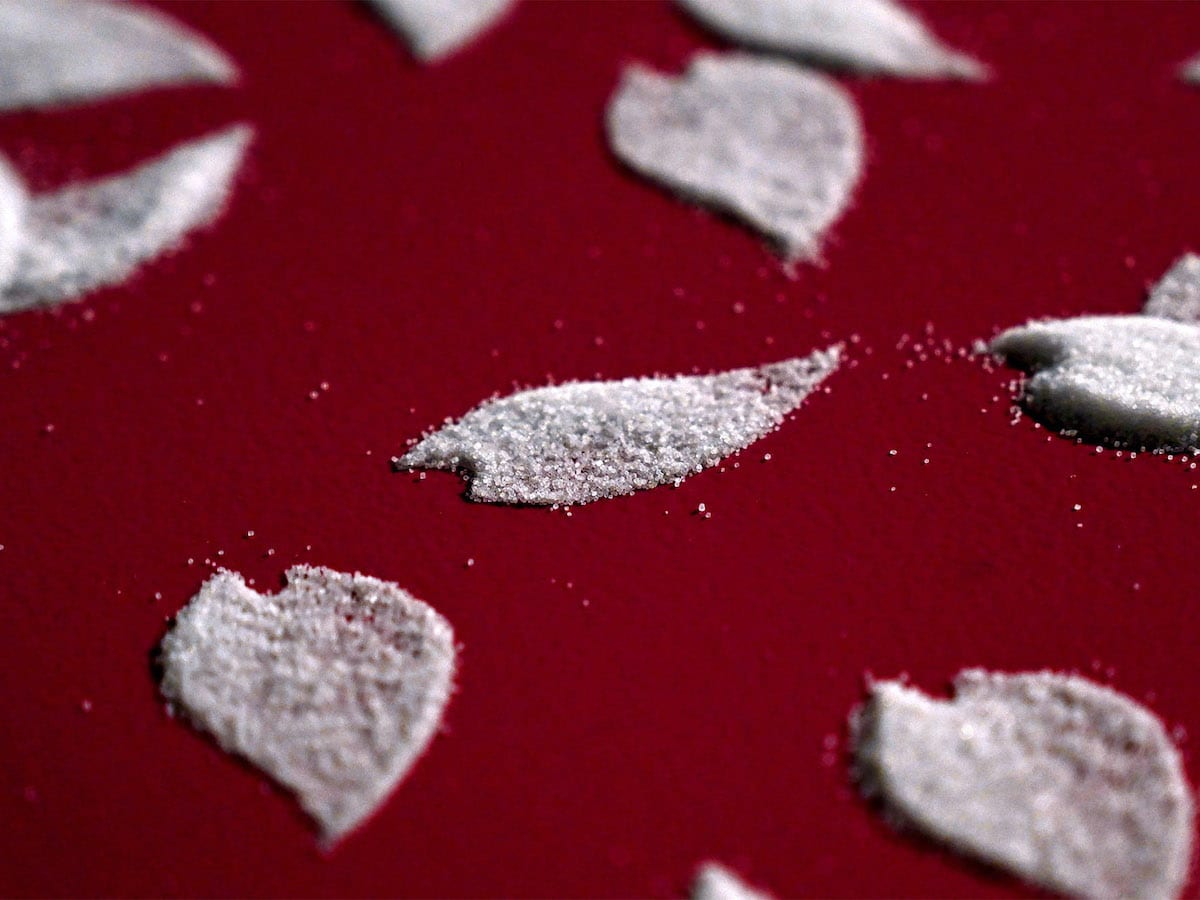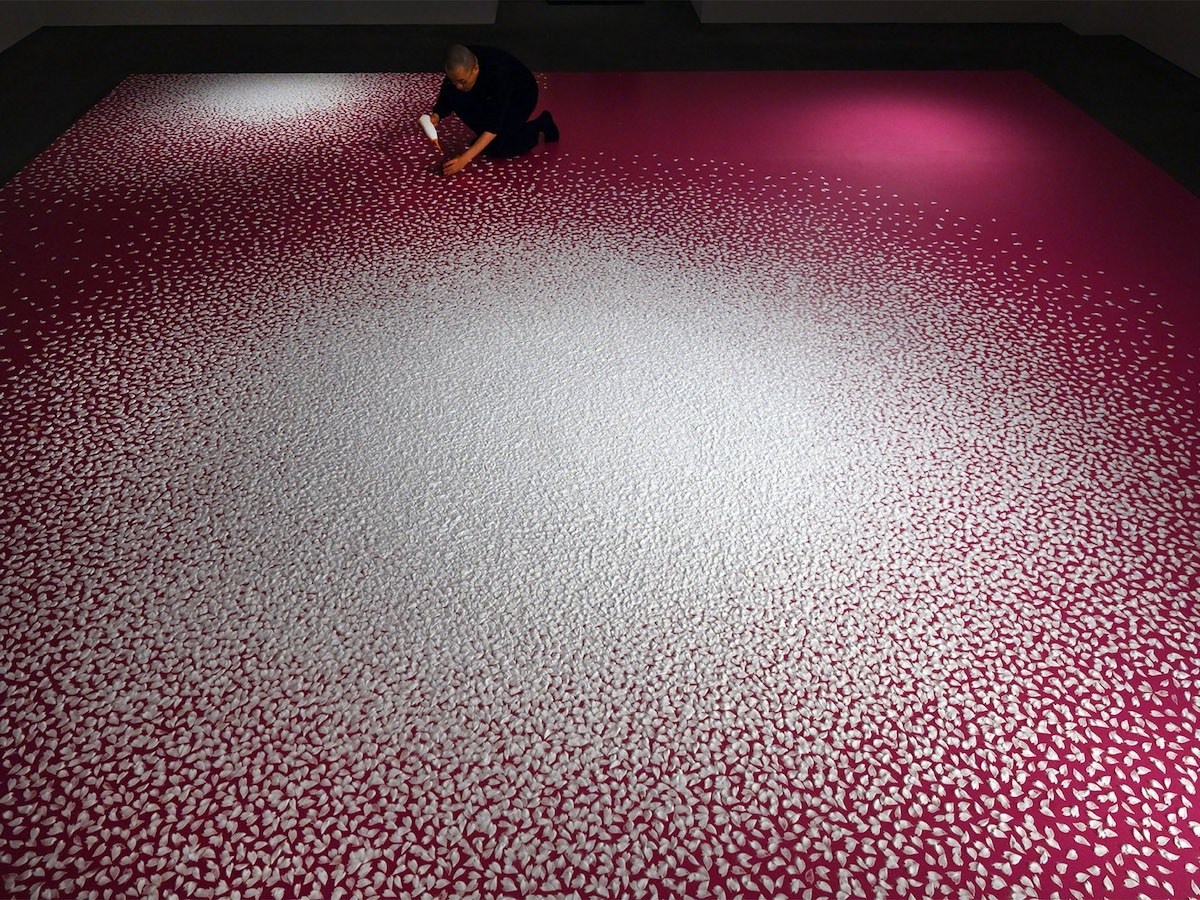
Photo: © Motoi Yamamoto 2021
Propelled by precious memories of loved ones lost, Japanese artist Motoi Yamamoto creates in order to preserve and cherish those sacred remembrances too often forgotten with time. Best known for his painstakingly crafted salt installations which he often shapes into labyrinthine patterns, the artist has recently completed a piece for a solo exhibition at the Setouchi City Museum of Art titled Sakura Shibefuru. In this latest installation, Yamamoto crafted over 100,000 fallen cherry blossom petals out of salt.
The remarkable installation is also displayed alongside two-dimensional works created earlier in the artist’s career, which he considers to be the starting point of his work. “The surface of the work that I first drew after my sister died of a brain tumor at a young age is also on display in this exhibition,” Yamamoto tells My Modern Met. “Since this was an attempt to engrave into my heart the moment when an important life ceased to exist, I left the patina emerging on the copper as it was. This creation can be seen as the origin of my work… I have continued creating my works for many years so that I will not forget my memories of loved ones.
“These creations are devices to ward against the self-defense instinct of oblivion and are like a habit that has taken root to retain memories that are lost over time. I have become interested in past events such as reminiscences and memories. However, when my wife died of illness four years ago, my life alone with my daughter began, and I became much more conscious of her future—in other words, what was still to come—and a shift began to occur in the way in which I approached my work.”

Photo: © Motoi Yamamoto 2021
Just as important as the installation's concept is the artist’s chosen medium: salt. In Japanese culture, salt has been equated with cleansing since ancient times. And in many other cultures around the world, the crystalline mineral is used in rites and rituals related to life and death. It is also necessary to maintain life and forms an essential part of the human diet that everyone has experienced or tasted at some point. For Yamamoto, this means that anyone can form a connection with his works through personal memories tied to the substance and shape their own meaning or interpretation from it.
“The main reason that I continue to use salt is because of its beautiful whiteness,” Yamamoto reveals. “Since salt is a colorless, transparent crystal, it has a slightly transparent quality when viewed from up close, and it is almost as if this soft whiteness is gently receiving the contents of my heart. I also use salt because it is a difficult medium to control and results in very fragile works. Salt does not bond together, so it breaks apart immediately when touched and dissolves when affected by humidity. These traits are a negative factor in terms of maintaining and protecting the work, but this instability always reminds me that all things are subject to change and that life is finite.”

Photo: © Motoi Yamamoto 2021
“At the end of an exhibition,” he continues, “we undertake the project of returning the salt to the sea. This essentially involves working together with the viewers to destroy the work and return the salt to the sea. But what I like about the process is that I only use this natural medium for a fleeting moment in my work before returning it to its place in nature. This project enables me to experience how my life in this world is a mere moment in the long, long passage of time.”
Similar to that concept, cherry blossoms also signify the transient nature of life. The term “sakurashibe-furu”—which the exhibition takes its title from—translates to “falling cherry stamens” and is a seasonal Japanese word used in haiku to signify late spring. In reality, these fallen buds denote the end of the flower season but also foreshadow the coming freshness and greenery of spring and midsummer. “While thinking about the future of the buds,” Yamamoto explains, “I created petals that had just fallen, piling the petals while contemplating the trees that produced these beautiful flowers with their thick trunks, supple branches, and powerful roots.”
The diligent and patient artist admits, “I keep creating works to resolve my own issues, but I hope that they provide viewers with an opportunity for contemplation while taking in the various settings and surroundings of the works. Many people who, like me, have lost a loved one can feel something from the works… I hope that this work will provide an opportunity to look into the future while reflecting back on cherished memories.”
Sakura Shibefuru opened at the Setouchi City Art Museum in Okayama, Japan on March 9 and will be on display until May 5, 2021. The artist will be creating his next large-scale installation titled LABYRINTH for the Oku-Noto Triennale 2020+ this fall. To keep up to date with Yamamoto’s latest work, visit the artist’s website and follow him on Instagram.
Japanese artist Motoi Yamamoto created over 100,000 fallen cherry blossom petals out of salt for his latest installation titled Sakura Shibefuru.

Photo: © Motoi Yamamoto 2021

Photo: © Motoi Yamamoto 2021

Photo: © Motoi Yamamoto 2021
The salt installation is displayed alongside two-dimensional works from earlier in the artist's career that he considers the starting point of all his work.

Photo: © Motoi Yamamoto 2021

Photo: © Motoi Yamamoto 2021
Yamamoto created these salt petals to signify the transience of life and to encourage viewers to reflect back on precious memories while also looking forward towards the future.

Photo: © Motoi Yamamoto 2021

Photo: © Motoi Yamamoto 2021






















































































